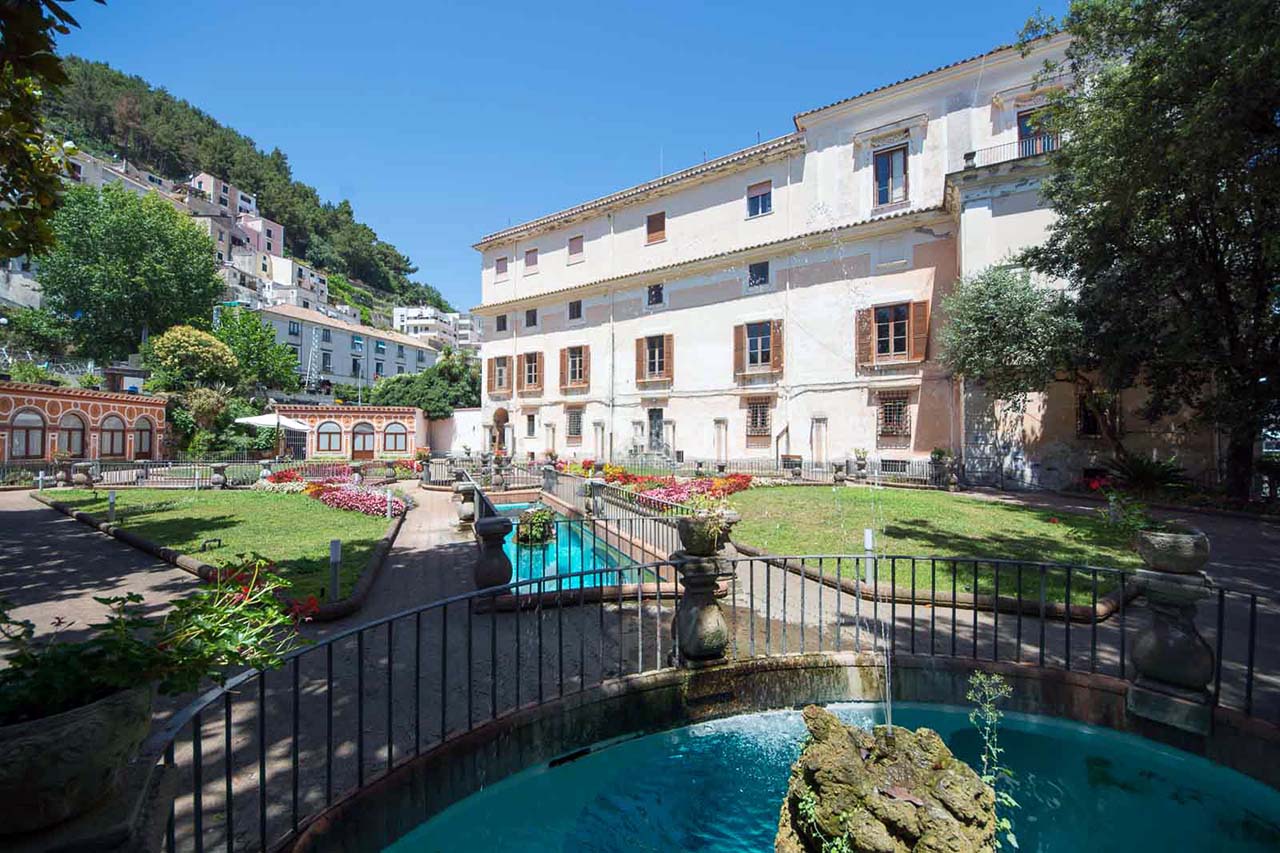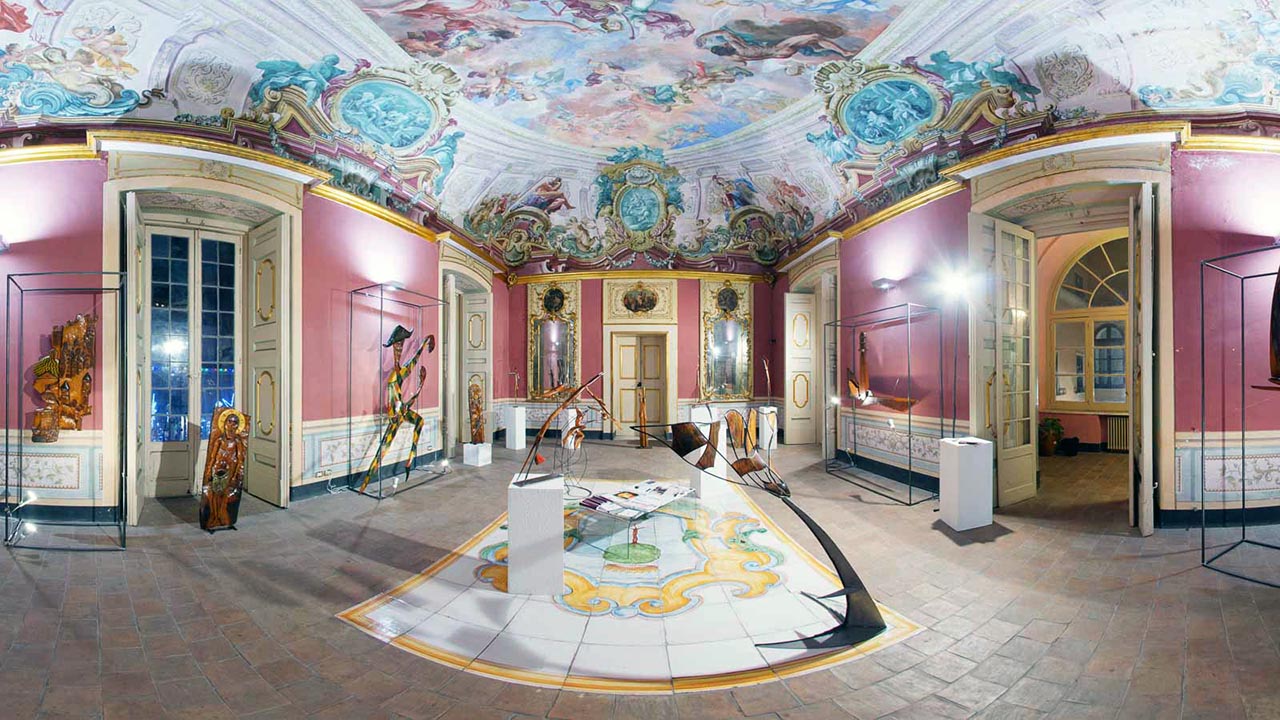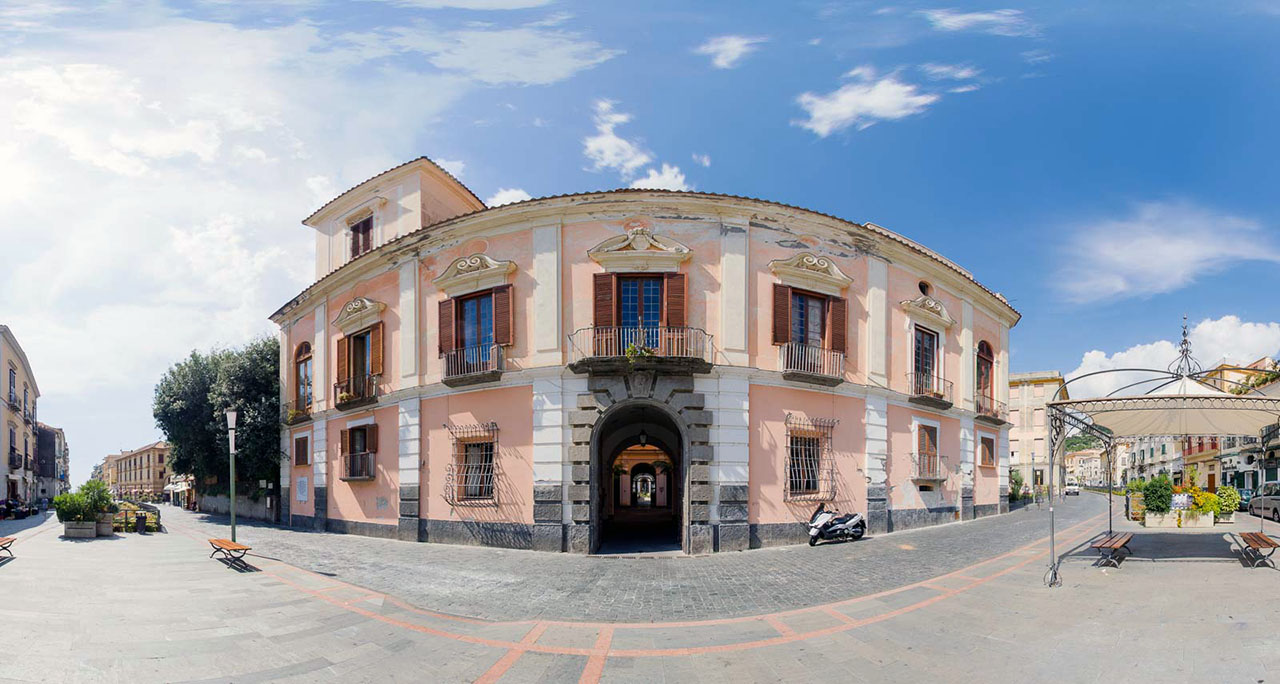It is one of the most exciting buildings of architecture and decoration of the eighteenth century. Inside, a series of paintings illustrate the allegory of feelings: from the noblest to the most violent ones.
June 13th, 2023. By Alfonso Mammato, photo by Salvatore Guadagno
In the heart of the Amalfi Coast, along the main street of Maiori, rises one of the area’s most intriguing and significant buildings, the Palazzo Mezzacapo: one of the most splendid examples of architecture and decoration of the eighteenth century. Today it is the seat of the municipal library, the cultural laboratory, and some municipality offices.
Interior gardens
The internal gardens are unique. From the curious shape of a Maltese cross from the rose garden violets, you overlook large underground pools, all communicating, crossed by a branch of the Reginna: a bizarre stratagem to enjoy a little ‘coolness during the summer months.
An illustrious eighteenth-century British writer and traveler, Lord Henry Swinburne, provides one of the first testimonies about the palace and the gardens. In September 1777, the writer undertook a journey to Salerno. Going up through Cava, he had reached the sanctuary of the Avvocata and descended towards Maiori.
In his book Travel in Two Sicilies, he describes, “I was admitted to a garden belonging to a gentleman now traveling that I admired with great pleasure as it was adorned in style happily suited to the location and climate. The palace is clean and airy, and the gardens are cut by clear water canals, each creating strong streams of water between rich and fragrant gardens or waterfalls through caves of worked shells and shady arbors.”

At the court of the Mezzacapo family
Once we enter the inner courtyard, we encounter two grand staircases that lead to the upper floor. The structures, furnishings, and many “costaiole” canvases are well preserved. Still, the natural attraction is the hall of the council, wonderfully frescoed by a pictorial cycle probably made in 1784 following the wedding between the Mezzacapo and Pepoli families. The frescoed work, painted (perhaps) by the painter Luciano Rachele, represents a nuptial allegory of a good omen for the marriage between the two families.

The history of conjugal love: Gods, heroes, nobility, and family
The Vittorico fresco cycle is composed of a quadrature part painted in illusion and the other with decorative figures and others that tell the story of this married vocation. A young woman, blonde, dressed in simple clothes illuminated by a radiant sun, holds open a book symbolizing the gratitude that governs the sphere of the world. The decorative cycle includes four corners with four divinities: Zeus, Athena, Poseidon, and Mercury.
The story of the fresco in the center is simple but effective. Apollo is depicted in the central fresco, giving a precise signal to Aurora: the time has come for the sun to rise, bringing a good omen about the wedding that is about to happen or has happened.
Below them are the bride and groom, ideally represented by a female and a male allegory. They are joined in marriage by a metaphor of the marriage bond, which identifies a rope, the symbol of union. All around is a concept of putti and allegorical figures, such as the probable one of the river Reginna, depicted by a man pouring out a wineskin, and references to the Amalfi Coast, including the presence of coral, mermaids playing with putti, and several other maritime references.
The four seasons and the wedding rite
Special guests at this essential wedding, there are the four seasons. Spring, the protagonist, because it is the renewed season of love, is represented by a young woman lying downplaying a flute observing the celebratory rite.
Under the metaphor of spring, cherubs represent winter, autumn, and summer. The peacock symbolizes the female nuptial allegory, an ancient symbol of purity of female virtue. The man shows what appears to be a pigeon set ablaze by a flame starting at the wrist. Perhaps this is a reference to the man’s duties within marriage.

Sacred and profane
To counterbalance the auspices of this marriage, four stories of pagan love with unhappy endings have been depicted. In these panels, the theme of love is illustrated in its aspects of suffering. In the workshop of Hephaestus, the master decided to go out to embrace his wife Venus, who, however, avoided him, anxious to join Mars.
The implausible story of the love of Diana and Endymion, a young man of rare beauty who gave up his life for an eternal night’s sleepover, which the Moon goddess, madly in love with him, watches over. The latter represents the allegory of spiritual elevation from the human condition to the divine.
The perhaps less recognizable story is Borea, God of the cold wind, who kidnaps the princess Orizia after repeated romantic rejections. In this case, it is about violent love. Finally, perhaps best known, the story of Apollo and Daphne, narrated in Ovid’s Metamorphosis, represents the allegory of chastity. To escape the amorous snares of Apollo, the beautiful Daphne asked her father, the river god Adonis, to be transformed into a laurel tree.
Female heroism
Over the hall’s door was painted the narrative of spiritual and moral love, a story that develops in three levels taken from Tasso’s Gerusalemme. There is the scene where Clorinda frees Olindo and Sofronia, Erminia rests on the bank of the Jordan, and Clorinda defends Tancredi in the battle of Jerusalem.
The selection of the three episodes is not random. From their abstraction emerges not only the theme of unconfessed love, timid and romantically dramatic but women’s protagonism in their heroism and generous impulse. The choice of inserting three episodes from Jerusalem Delivered accentuates the idyllic dimension of the culture of the time, connecting with the remaining decoration of the mythological-allegorical style of the hall.
*Alfonso Mammato is a student at the Marini – Gioia Technical Economic Institute for Tourism in Amalfi, who participated last year in a competition for young authors promoted by Authentic Amalfi Coast.

